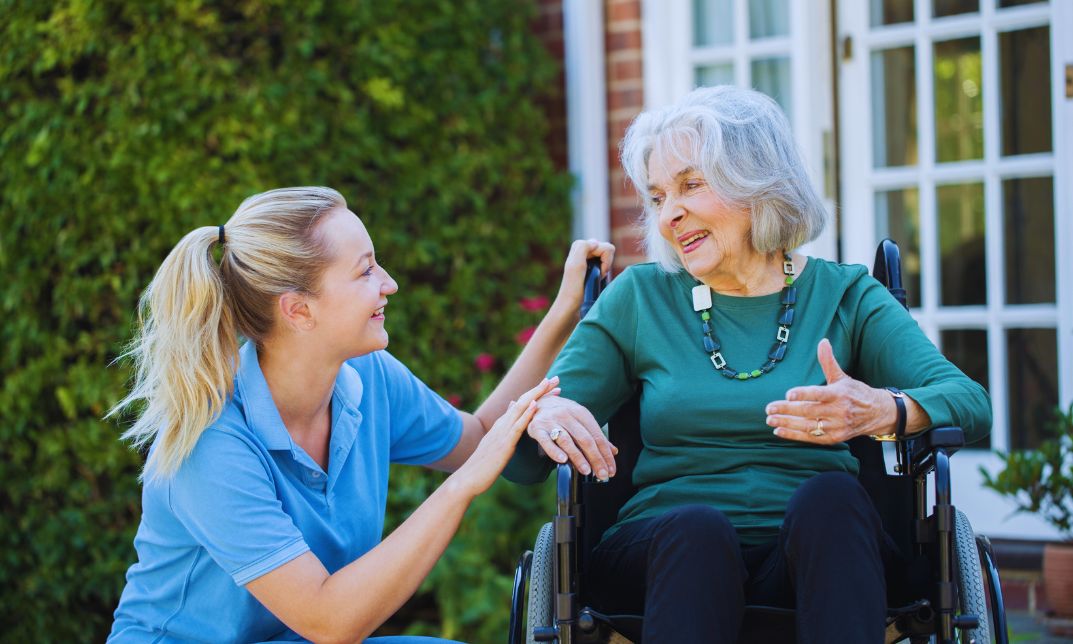No products in the basket.
Effective communication is not just helpful — it’s essential. It keeps people safe and helps staff give the right care. It builds trust and protects dignity. So, why is communication important in health and social care — because every conversation shapes someone’s wellbeing. Whether it’s a nurse giving medicine instructions, a carer offering comfort, or a doctor explaining a diagnosis, the way we talk matters. And the clearer we are, the better care people receive.
Let’s explore what makes communication so powerful — and what happens when we get it wrong.

The Basics: What Good Communication Looks Like in Care
Good communication means sharing messages clearly and kindly. It’s about talking with people, not at them. It also means listening properly. In health and social care, we use three main types of communication:
- Verbal – using words to talk and explain.
- Non-verbal – using body language, tone, and gestures.
- Written – using records, emails, care plans, and reports.
Verbal communication might include giving advice or discussing care. A carer might ask, “How are you feeling today?” or explain a routine. But it’s not just about speaking — it’s about listening, too. That builds trust and shows respect.
Non-verbal cues say a lot. Eye contact, nodding, a calm voice — these all help people feel heard and valued. A rushed tone or crossed arms might do the opposite.
Written communication keeps care safe. Care notes, medication charts, appointment letters — they must be accurate and easy to follow. With digital tools like the NHS App, patients can also book visits or see results online. This helps keep everyone in the loop.
Why Is Communication Important in Health and Social Care?
When we talk well, care works better. Poor communication creates risk. It leads to mistakes. It leaves people confused or anxious. Clear communication keeps care on track.
Miscommunication causes around 80% of serious medical errors. These aren’t small problems. They can lead to the wrong treatment, or even harm. A simple missed message during a shift handover could mean a patient doesn’t get the help they need. Now flip that around. When staff speak clearly and listen carefully, the results are better. Patients understand their treatment. They follow advice. They feel safe. That lowers the risk of mistakes.
Good communication also helps teams. Staff know what’s happening. They work together smoothly. They support each other and deliver joined-up care. That’s how we keep people safe.
Patient Safety Depends on Clear Conversations
One wrong word can have big consequences. Think about a nurse explaining when to take a tablet. If the message is unclear, the person might take too much — or not enough. Clear, step-by-step instructions matter. So does checking that the person has understood. Asking “Can you tell me how you’ll take this?” helps spot confusion early.
Communication is also key during handovers. That’s when one team passes care to another. If details get left out, people might not get the right help. This could delay treatment or cause harm. Clear communication stops this. Everyone knows the plan. Everyone understands the person’s needs. And that saves time, money, and lives.
Talking as a Team: Communication Across Roles
No one works alone in health and social care. Doctors, nurses, carers, social workers, and therapists all share the same goal: to help people live well. They need to talk to each other to do that. This is called multidisciplinary communication. It means sharing updates, attending team meetings, and using one shared care plan. For example:
- A GP shares test results with a district nurse.
- A social worker updates the care home about new support needs.
- A physiotherapist adds notes to the patient record.
When teams talk, they avoid repeating tasks. They prevent gaps in care. Everyone stays on the same page. This improves the care experience for the patient and reduces stress for staff. Digital records help with this. Everyone involved can read the same notes. That supports quicker, safer decisions.
Legal and Ethical Reasons to Communicate Clearly
Good communication isn’t just helpful. It’s the law. It’s also an ethical duty. UK laws and guidelines make this clear:
- Health and Social Care Act 2008 – Staff must treat people with dignity and respect. That includes how they speak and listen.
- Care Act 2014 – Local councils must involve people in their own care planning.
- Mental Capacity Act 2005 – Before making decisions for someone, you must first try to support their own choices. That takes good communication.
- Equality Act 2010 – People with disabilities or language needs must be given support to understand and express themselves.
- Data Protection Act 2018 (GDPR) – Personal information must be shared safely and only when needed for care.
Regulators check for this. The Care Quality Commission (CQC) inspects how services communicate. They look for clear notes, person-centred planning, and respectful interactions. Professional bodies also expect high standards. The GMC and NMC both state that care professionals must speak clearly, listen well, and check understanding.
Digital Tools Are Changing How We Communicate
The NHS is moving towards integrated care systems (ICSs). These link hospitals, GPs, community care, and social services. To work, they rely on fast, clear, and secure communication.
The NHS App is part of this. It helps patients book appointments, view records, and get health advice. This gives people more control. It also saves time for staff. Digital records help everyone share the same facts. This cuts down mistakes and delays. It’s not about replacing human interaction — it’s about supporting it.
That said, digital tools only work if staff and patients understand how to use them. Training and support are essential.
Common Barriers to Good Communication
Even skilled staff can face problems. These are some of the biggest obstacles:
- Time pressure – Staff often feel rushed. Short chats may miss key points.
- Staff shortages – When teams are stretched, communication suffers.
- Language barriers – Not everyone speaks English well. Interpreters help, but they’re not always available.
- Jargon – Medical words confuse people. Say things simply.
- Stress – Both staff and patients may feel emotional. This can block clear thinking or listening.
- Unclear records – Messy or missing notes cause confusion.
These barriers lead to mistakes and poor experiences. Being aware of them helps us find solutions.
How to Tailor Communication to the Person
There’s no one-size-fits-all. Good care means asking, “What’s the best way to speak with this person?” People with learning disabilities may need simple words or pictures. They may need more time to process information. Ask short questions. Use easy-read documents. Check understanding slowly and clearly.
People with mental health needs may feel anxious. Speak calmly. Listen without judgment. Ask what matters to them. Someone who is deaf or blind may need specific tools. This could be a sign language interpreter, large print, or a talking device. Always ask what works best for them.
People with dementia may need slow speech, gentle tone, and patience. Use names and simple phrases. Avoid rushing or interrupting. For children, play or pictures can help. Use honest, kind words. Involve their parent or carer. Tailored communication builds confidence. It helps people take part in their own care.
Communication Builds Trust and Improves Care
Trust doesn’t just appear — it grows through good communication. When people feel listened to, they relax. They feel respected. They’re more likely to follow advice, attend appointments, and ask questions. Clear, kind words show that we value the person. That helps build a strong care relationship.
Good communication also improves efficiency. When staff share information well, things run smoother. Referrals happen on time. Fewer tests get repeated. Records stay up to date. This saves money and protects staff time. It also helps patients get what they need, faster.
Looking Ahead: Why It Matters More Than Ever
As we move into 2025, care is changing. Services are more connected. There’s more focus on prevention and community-based support. This means more teamwork and more communication.
We also face growing demand and limited resources. Good communication helps care run smoothly. It makes sure people don’t fall through the cracks. Clear messages can even prevent illness. Public health teams share advice about food, activity, or smoking. That only works if people understand and trust what’s said.
A health and care system built on clear, kind communication will always work better — for patients and staff.
Final Word
So — why is communication important in health and social care? Because it’s the thread that holds everything together. It keeps people safe, builds trust, helps teams work well and cuts down on mistakes. It supports better health and wellbeing.
Every conversation, every note, every check-in matters. Communication isn’t just a soft skill—it’s the foundation of safe, person-centred care. So let’s keep it clear. Let’s keep it kind. And let’s make every interaction count.
Want to deliver safer, more person-centred care? Join our online Health and Social Care courses at Course Cave and build strong, confident communication skills.




